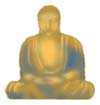|
 Meditation Meditation
 Meditation is a state of relaxation and introspection and an easy way to relax and rejuvenate your body.
There are numerous physical benefits one can gain from meditation. It can lower your blood pressure, lower your heart rate, help
you sleep, and can reduce stress and stress related problems. Meditation is a state of relaxation and introspection and an easy way to relax and rejuvenate your body.
There are numerous physical benefits one can gain from meditation. It can lower your blood pressure, lower your heart rate, help
you sleep, and can reduce stress and stress related problems.
Meditation can also serve as a training tool to cleanse the mind.
Buddhists use meditation to replace negative qualities in the mind with positive ones. Ideally, the mind is cleansed of impurities
such as desire, jealousy, anger, and hatred, and they are replaced with love, compassion, happiness and kindness.
Physically, meditation is very similar to self-hypnosis, but in meditation the goal is to simply relax and become aware of yourself. Both methods
begin with breathing techniques, quieting the mind, relaxing the body and becoming aware of the present. The largest difference between the two is
that in meditation you concentrate only on the present, and you simply let things happen without attempting to alter them. Self-hypnosis is used
more as a tool to change and reorganize your inner self.
Meditation Steps:
1. Find a quiet and peaceful location.
2. Prepare the area (meditation music, mats, candles, whatever helps you relax).
3. Sit in your chosen spot (floor, chair, wherever
you are most comfortable),
keeping your back straightened.
4. Close your eyes and begin breathing exercises. Take a deep breath, allowing the air to expand your
stomach, and then slowly exhale. Concentrate on this rhythm.
5. Clear your mind of all thoughts, then slowly let them enter. Contemplate
each thought one at a time.
|